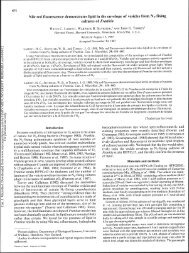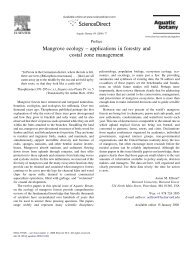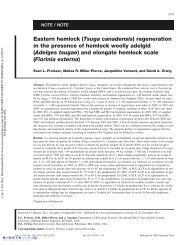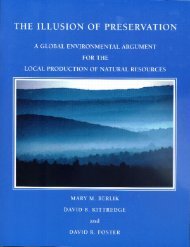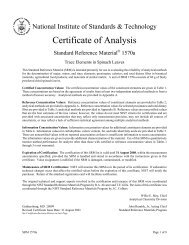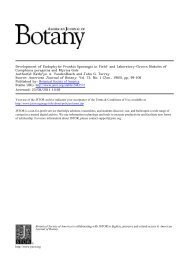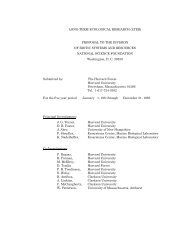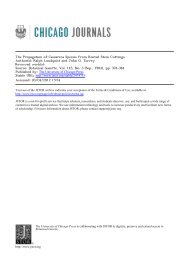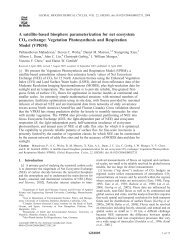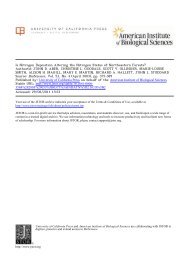Abstracts of Papers - Harvard Forest - Harvard University
Abstracts of Papers - Harvard Forest - Harvard University
Abstracts of Papers - Harvard Forest - Harvard University
You also want an ePaper? Increase the reach of your titles
YUMPU automatically turns print PDFs into web optimized ePapers that Google loves.
southwestern Nova Scotia. Two <strong>of</strong> the rarest <strong>of</strong> these<br />
species are Sabatia kennedyana and Coreopsis rosea<br />
found only in the Tusket area <strong>of</strong> Yarmouth Co. In the<br />
summer <strong>of</strong> 1982, this area was explored to obtain in-<br />
formation on abundance, distribution and threats to<br />
these species. Both were found on gently sloping,<br />
sheltered, gravel and peat lakeshores which are<br />
alternately flooded and exposed with fluctuating<br />
river levels. During low water years, these species<br />
flower (July to Sept.). As well, they reproduce by<br />
stolons or rhizomes. S. kennedyana occasionally<br />
forms dense colonies (two bays had more than 1000<br />
plants in flower). C. rosea was restricted to two<br />
lakes through which the Tusket R. flows plus one that<br />
drains directly into it. S. kennedyana occurred in<br />
six lakes forming part <strong>of</strong> a 30km stretch <strong>of</strong> the river<br />
and two lakes draining into it. When Fernald col-<br />
lected in 1920 and 1921, both species were also<br />
present in the lowest lakes in the Tusket and Carleton<br />
river systems, but have since been eliminated from<br />
the lower Tusket (and probably Carleton) lakes be-<br />
cause they have been turned into reservoirs for the<br />
Tusket Falls generating station. In the remaining<br />
lakes, the major threat to both species now is cot-<br />
tage development accompanied by vehicle traffic along<br />
the shoreline during low water periods. Some <strong>of</strong> the<br />
largest populations <strong>of</strong> S. kennedyana and the largest<br />
population <strong>of</strong> C. rosea occur on shorelines which are<br />
already heavily cottaged.<br />
KEELER, KATI-ILEEN H. School <strong>of</strong> Life Sciences<br />
<strong>University</strong> <strong>of</strong> Nebraska, Lincoln, NE 68588-0118<br />
- Plants with Extrafloral Nectaries in Ecosystems<br />
Without Ants<br />
Extrafloral nectaries are plant glands which secrete<br />
water, sugars, and amino acids present anywhere<br />
except in the flower. These secretions attract numerous<br />
nectar-feeding insects other than pollinators.<br />
They have been repeatedly shown to be the site <strong>of</strong> antplant<br />
mutualism: plants are protected from herbivores<br />
by ants while the ants receive food. Since<br />
there are no ants native to Hawaii, it was hypothesized<br />
that none <strong>of</strong> the endemic plants would have<br />
extrafloral nectaries.<br />
Thirty-one <strong>of</strong> 614 species growing in Hawaii Volcanoes<br />
National Park have extrafloral nectaries. Ten<br />
<strong>of</strong> these are <strong>of</strong> pantropic distribution or were introduced<br />
by the Polynesians, 19 are recently introduced<br />
exotics and 2 are endemics. Acacia koa, (Fabaceae)<br />
and Pteridium aquilinum var. decompositum (Polypodiaceae)<br />
are the endemics with functional extrafloral<br />
nectaries. Two species which produce extrafloral<br />
nectar elsewhere, Passiflora foetida and Ipomoea<br />
indica do not secrete nectar in H.V.N.P. The abundance<br />
<strong>of</strong> EFN-plants in H.V.N.P. communities is low:<br />
except for koa-dominated sites, cover by plants with<br />
extrafloral nectaries was less than 3%. It is impossible<br />
to evaluate the complete flora <strong>of</strong> the Hawaiian<br />
islands but plants with EFNs occur occassionally<br />
in additional endemic species, e.g. Ipomoea tuboides<br />
(convolvelaceae), and Hibiscus (Malvaceae), and an<br />
endemic genus, Kokia (Malvaceae). Despite this,<br />
frequency <strong>of</strong> plants with extrafloral nectaries is<br />
very low in Hawaii compared to other floras. It is<br />
hypothesized that plant species evolving in Hawaii<br />
tended to lose nectaries, but that a few species<br />
established mutualism with some, presently unknown<br />
Hawaiian invertebrate.<br />
Ecological Section 49<br />
LABOVITZ, MARK L., ROBIN BELL*, AND EDWARD J.<br />
MASUOKA. NASA/GSFC, Code 922, Greenbelt, MD<br />
20771. -Delay <strong>of</strong> winter dormancy recovery in<br />
Quercus spp.<br />
mineralization.<br />
associated with anomalous soil<br />
Vegetation growing in mineralized versus non-mineralized<br />
soil was examined in early Spring for the<br />
potential <strong>of</strong> using remote sensing techniques to<br />
discriminate the two environments. Two test sites,<br />
located in the Mineral Sulphide District, Louisa<br />
County, VA, differed only in that one was situated<br />
on a mineralized contact. At both sites, 16 trees<br />
(Quercus spp., predominantly Q. alba L.) arranged in<br />
a 4x4 matrix, were observed repeatedly during recovery<br />
from winter dormancy. As buds broke, the<br />
percentage <strong>of</strong> burst versus closed was tallied.<br />
During leaf flush, nominally 50 measurements per<br />
tree <strong>of</strong> the maximum blade lengths both parallel<br />
to and normal to the midvein were collected.<br />
Results show 1) the percentage <strong>of</strong> buds burst<br />
remained higher at the non-mineralized site for<br />
more than two weeks after observable recovery from<br />
dormancy had begun; and 2) non-mineralized leaves<br />
possessed a greater surface area for a period <strong>of</strong> at<br />
least two weeks.<br />
LACEY, ELIZABETH P. AND CINDY CAPPS Department<br />
<strong>of</strong> Biology, <strong>University</strong> <strong>of</strong> North Carolina,<br />
Greensboro, NC 27412 - Latitudinal variation in<br />
seed viability in Daucus carota.<br />
Daucus carota grows in old fields and along<br />
roadsides from Georgia into southern Canada. Seed<br />
tests both indoors under controlled conditions and<br />
outdoors in experimental plots show that southern<br />
populations set fewer viable seeds than do northern<br />
populations. Tests <strong>of</strong> seeds produced in reciprocal<br />
transplant plots in North Carolina and Michigan<br />
indicate that these differences are environmentally<br />
rather than genetically based. Developing seeds in<br />
southern populations appear to suffer more insect<br />
damage, suggesting that biotic factors may help<br />
regulate population size more in the southern part<br />
<strong>of</strong> the species' range.<br />
LECHOWICZ, MARTIN J. Department <strong>of</strong> Biology,<br />
McGill <strong>University</strong>, Montreal, Quebec, Canada<br />
H3A lBl - The defenses <strong>of</strong> deciduous trees against<br />
defoliation by the gypsy moth, Lymantria dispar<br />
From 1979 through 1981 I studied the leaf character-<br />
istics <strong>of</strong> 14 deciduous tree species in a southern<br />
Quebec forest in relation to their utilization by<br />
gypsy moth. Traits that might influence host selec-<br />
tion by gypsy moth were monitored: leaf phenology,<br />
toughness, water content, nitrogen concentration,<br />
tannin and phenolic concentrations, and leaf acidity<br />
and buffer capacity. Defoliation was higher on tree<br />
species that have more tender, nitrogen- and water-<br />
rich foliage during the period <strong>of</strong> larval dispersal<br />
in early spring. Since these qualities favorable<br />
for gypsy moth larvae diminish rapidly with leaf<br />
age, trees that leaf out relatively early escape<br />
serious defoliation. Defoliation levels among trees<br />
leafing out later are mediated at least in part by<br />
leaf chemistry. Defoliation is less on trees with<br />
young leaves that have relatively high concentra-<br />
tions <strong>of</strong> condensed tannins and greater on trees with<br />
acidic young leaves rich in phenolics and hydrolyz-<br />
able tannins but poor in condensed tannins.




